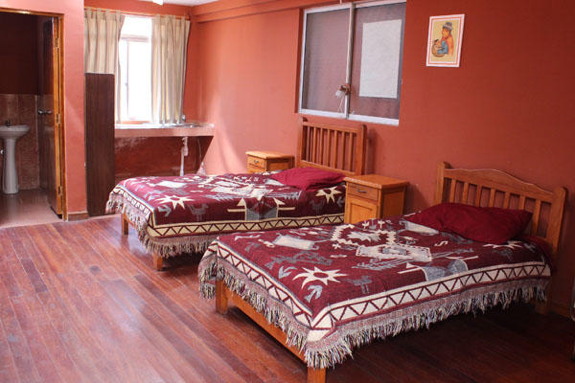
(above) A delivery room with cultural adjustments, which include wooden floors and a bed for family members who accompany the expectant mother, in the hospital in Patacamaya, Bolivia.
Credit: Sara Shahriari
In birthing rooms, Bolivia sees way to cut maternal deaths
July 18, 2013 - Christian Science Monitor
Some Bolivian hospitals are working to make their delivery rooms more like rural homes.
By Sara Shahriari, Correspondent
Patacamaya, Bolivia – When Gregoria Vilca went into labor, she didn't want to go to the hospital, despite knowing the dangers that can come with childbirth. As a traditional healer in her community, Ms. Vilca had seen many healthy home births, including her first five children, but she had also seen myriad complications.
 (left) Mirian Figueroa Vergara with her newborn daughter in a delivery room with cultural adjustments in the hospital in Patacamaya, Bolivia. Credit: Sara Shahriari
(left) Mirian Figueroa Vergara with her newborn daughter in a delivery room with cultural adjustments in the hospital in Patacamaya, Bolivia. Credit: Sara Shahriari
Though it has significantly decreased in recent years, Bolivia has one of the highest rates of maternal mortality in the Western hemisphere, with an estimated 190 maternal deaths for every 100,000 live births. Some women deliver in their isolated rural homes, without any health professionals nearby, and hours of travel over poor roads to reach medical care can be too long in the case of post-natal hemorrhaging, which is the single greatest cause of maternal death in the nation.
But hospitals are viewed as cold and foreign. Mothers are separated from their family and often left with doctors who don't speak their indigenous language. Vilca was shy about exposing her body to strangers, and had heard stories that scared her. "Sometimes in the hospital they'd have you as if you were crucified. Hands, feet, everything," Vilca says. "I didn't want that … so I didn't want to go."
Over the past few years, new initiatives across the country are trying to bridge the gap between home and hospital births – and the cultural differences – in an effort to save mother's lives while honoring traditional practices.
A typical home birth in western Bolivia is markedly different from a hospital birth: The family prepares medicinal teas like chamomile, and the room is dark and warm. The mother moves around freely and gives birth in the position that is most comfortable for her, instead of being obligated to lie down.
The new Bolivian health policies aim to improve maternal and child health by incentivizing childbirth with trained health professionals, be it in a hospital or at home, and by embracing intercultural medicine that seeks to combine the knowledge of local healers with Western skills. Part of that shifting policy has led some hospitals to build "culturally appropriate" delivery rooms – consisting of amenities normally available in a traditional home birth, such as space to cook food and prepare teas, and wooden floors as opposed to cold tile.
At Home in the Hospital?
Rosalva Gonzales Condori is a doctor at the hospital in the town of Patacamaya, one of the regions trying this new, integrated approach to fighting maternal mortality. Working with the local government and funding from Spain, the hospital built three new delivery rooms. The walls are painted dark orange, and each room has two beds, one for the mother and another for the family members who accompany her. There is a private bathroom, a stove, and shaded skylights to bring warmth to the cold high-altitude air.
Every month in Patacamaya between 30 and 35 children are born in the hospital. Some 50 percent of mothers who give birth at the hospital use these new delivery rooms, which were first implemented in 2009. One of them, Mirian Figueroa Vergara, lay tucked under heavy covers in a wooden bed with her baby girl at her side, and her mother and a midwife nearby. A pot of soup was on the stove. "The regular delivery rooms are so cold," Ms. Figueroa Vergara says." That's why I chose to come here."
It's a shift in her family tradition, as Figueroa Vergara's mother gave birth at home because she was afraid of the hospital.
Dr. Gonzales Condori says a key part of her hospital's project involves the presence of traditional midwives from local communities in the delivery room. It's a dramatic change in a country that for centuries excluded indigenous people and indigenous knowledge from "official" spaces like schools and hospitals.